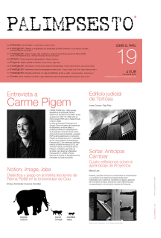Reflecting and multiplicity: Peter Smithon’s empoolings
DOI:
https://doi.org/10.5821/palimpsesto.19.7020Keywords:
Empooling, Smithson, Tecta, Reflecting, Multiplicity.Abstract
In April 1997, Peter Smithson gave a lecture entitled Empooling. He pointed out that this term was meant to: “where there is a sandy beach with rocks standing-up from it, as the tide recedes small formation of the building carry with it an empooling of the space-between. And as with the rock-pools what it within space-between seems extraordinarily vivid”.
The word was used to explain the works that they had done in the Tecta Factory. He defined three empoolings: the first was a polished stainless steel plate located at the entrance of the factory, so that it reflected everything that was placed in front of it; the second was a porch that allowed to see the landscape from inside the factory, from the toilets, and the third was a light and elevated lookout located in the garden court of the factory to view the countryside beyond its limits.
These three little works show us different strategies where they try to find a way to enrich the space-between defined by the building, a seventies factory without any interest. For this, a kind of “empooling” is built in order to improve the building’s relationships with its surroundings, as well as to qualify everyday life of workers inside the factory. As it happens in the whole of the Smithsons’ work, the project focuses on two principles: the understanding of architecture as an inseparable part of the space around and the consideration of inhabitants and their acts as incentive for their designs, obviating the objectification of architecture.
The procedure, that they used to achieve these objectives, show us how one purpose can be made of different ways, teaching us architecture transpositions are not always linear.
Downloads
Published
Issue
Section
License
PROTECTION AND INTELLECTUAL PROPERTY CRITERIA
Authors whose work is published in en Palimpsesto agree to the following terms:
1. The author retains the copyrights and guarantees the magazine the right to apply a Creative Commons Attribution-NonCommercial-NoDerivatives (CC BY-NC-ND), which permits others to share the work with acknowledgement of authorship.
2. The author may establish additional agreements of his or her own accord for non-exclusive distribution of the article published in the magazine (for example, in an institutional repository, or published in a book).
3. Electronic distribution of the work by the author(s) is permitted and encouraged (for example, in institutional repositories or on the author’s own website), prior to, and during the submission process, as this can generate productive exchanges, as well as earlier and greater citation of the published works (see The Effect of Open Access) (in English).
4. The author or provider of the material submitted for publication authorizes Palimpsesto to publish, with no obligation whatsoever (financial or otherwise) to the content of said material, be it in paper or digital format, or in any other medium.
5. The author or provider guarantees that he or she is the owner of the Intellectual Property rights to the contents provided, which encompasses the text and images/photographs/photographic works incorporated in the article.
6. The author or provider, exempts Palimpsesto magazine of all and any responsibility relating to violation of copyrights, thereby committing himself or herself to undertaking all efforts to assist Palimpsesto magazine in defence of any accusation, extra-judiciary, and/or judicial measures. Likewise, the author or provider will assume payment to Palimpsesto of any sum or compensation that must be paid to third parties for failure to comply with these obligations, be it the result of judicial, arbitrary or administrative decisions.
7. The submission of the texts by authors implies automatically a declaration of non plagiarism of its contents







